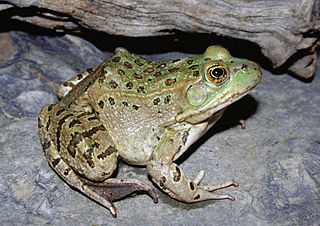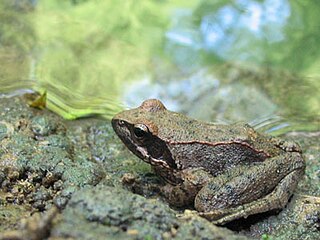
Leptodactylus fuscus is a species of frog in the family Leptodactylidae. Its local names are rana picuda and rana silbador.

The Central Asiatic frog, or Asian frog, is a species of true frog, found in China, Kazakhstan, and Kyrgyzstan. Its natural habitats are temperate forests, temperate shrubland, temperate grassland, rivers, intermittent rivers, swamps, freshwater lakes, intermittent freshwater lakes, freshwater marshes, intermittent freshwater marshes, freshwater springs, inland deltas, arable land, pastureland, rural gardens, urban areas, water storage areas, ponds, aquaculture ponds, and irrigated land. It is not considered threatened by the IUCN.
The Chaochiao frog is a species of frog in the family Ranidae, found in China and possibly in Myanmar and Vietnam. Its natural habitats are temperate forests, subtropical or tropical moist montane forests, subtropical or tropical high-altitude shrubland, subtropical or tropical high-altitude grassland, rivers, swamps, freshwater lakes, freshwater marshes, intermittent freshwater marshes, ponds, irrigated land, and canals and ditches. It is not considered threatened by the IUCN.
The chevron-spotted brown frog is a species of frog in the family Ranidae, endemic to Mount Emei, Sichuan, China. Its natural habitats are temperate forests, freshwater marshes, and intermittent freshwater marshes. It is threatened by habitat loss.

The Chiricahua leopard frog is a species of frog in the family Ranidae, the true frogs.
The Emei music frog is a species of frog in the family Ranidae. It is endemic to China, and is found in central China, in southeastern Sichuan, northeastern Yunnan and western Guizhou provinces. The species name refers to the type locality, Mount Emei in Sichuan, and its vocalizing abilities. The original name Rana musica was replaced with Rana daunchina as the former name was already taken.

The common green frog is a frog species of in the true frog family Ranidae; some sources still use the old name Rana erythraea. It lives in Southeast Asia and is also known as green paddy frog, red-eared frog or leaf frog. The last name, however, commonly refers to the Neotropical tree frogs which make up the subfamily Phyllomedusinae. These are not closely related to H. erythraea, belonging to family Hylidae instead.

Hylarana guentheri is a species of frog in the family Ranidae. It was formerly placed in the genus Rana. It is found in China, Hong Kong, Macau, Taiwan, Vietnam, and possibly Cambodia and Laos. An introduced population is found on Guam. It can live as high as 1100 meters above sea level. An alternate common name is Günther's Amoy frog, and the honorific is often spelled "Guenther's".

The Italian stream frog, also called the Italian frog, is a species of frog in the family Ranidae. The species is endemic to Italy and San Marino.
The plateau brown frog or plateau wood frog is a species of frog in the family Ranidae, endemic to the plateau region of western China. It was previously included in Rana chensinensis but it now considered a valid species. It is a common frog in suitable habitats that include alpine meadows, marshland and grassland. It hibernates in streams. It is not considered threatened by the IUCN.

Hylarana latouchii, also known as Kuatun frog, La Touche's frog, or broad-folded frog, is a species of frog in the family Ranidae. It was formerly placed in genus Rana. The specific name honours the collector of the type series: "Hylarana" latouchii was described by George Albert Boulenger based on three specimens collected by Irish ornithologist John D. La Touche in Guadun village in Wuyishan, Fujian, China.

The long-legged wood frog, also known as Caucasus frog, Brusa frog, or Uludağ frog, is a species of frog in the family Ranidae found in Armenia, Azerbaijan, Georgia, Iran, Russia, Turkey, and Turkmenistan.

The Hokkaidō frog or the Ezo brown frog is a species in the family Ranidae found in Hokkaidō, Japan, and Sakhalin, Russia. Its natural habitats are boreal forests, temperate forests, temperate shrubland, temperate grassland, rivers, swamps, intermittent freshwater lakes, freshwater marshes, intermittent freshwater marshes, arable land, ponds, and irrigated land.
The Sichuan frog is a species of frog in the family Ranidae found in China and possibly Myanmar. Its natural habitats are temperate shrubland, temperate grassland, rivers, intermittent rivers, swamps, freshwater marshes, and intermittent freshwater marshes.

Vaillant's frog is a species of frog in the family Ranidae found in Central America. Its natural habitats are subtropical or tropical dry forests, subtropical or tropical moist lowland forests, subtropical or tropical swamps, rivers, swamps, freshwater lakes, intermittent freshwater lakes, freshwater marshes, intermittent freshwater marshes, rural gardens, heavily degraded former forests, water storage areas, ponds, and canals and ditches.

The lowland leopard frog is a species of frog in the family Ranidae that is found in Mexico and the United States.
Rana zhengi is a species of frog in the family Ranidae that is endemic to Sichuan, China.

The Zhenhai brown frog is a species of frog in the family Ranidae endemic to China. Its natural habitats are subtropical or tropical moist lowland forests, montane forests, dry lowland grasslands, intermittent freshwater marshes, ponds, and irrigated land. It is not considered threatened by the IUCN.

Chirixalus doriae, commonly known as Doria's Asian treefrog, Doria's bush frog, Doria's bush frog, and Doria's tree frog, is a species of frog in the family Rhacophoridae. It is found in southeastern Asia, from extreme northeastern India and adjacent Bangladesh to Myanmar, Thailand, Cambodia, Laos, Vietnam, and southern China.

The Chinese flying frog or Chinese gliding frog is a species of tree frog in the family Rhacophoridae found in China, Laos, Burma, and Vietnam. It is also known as Blanford's whipping frog, large treefrog, and Denny's whipping frog.















